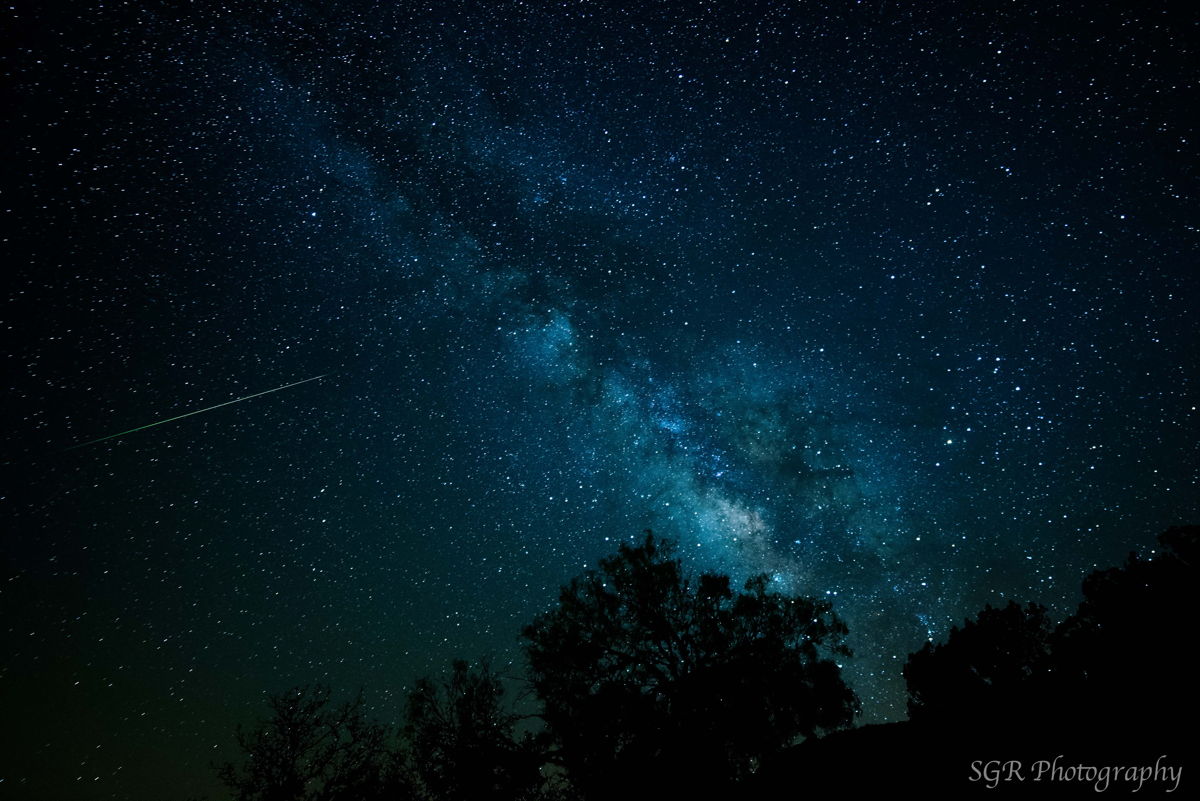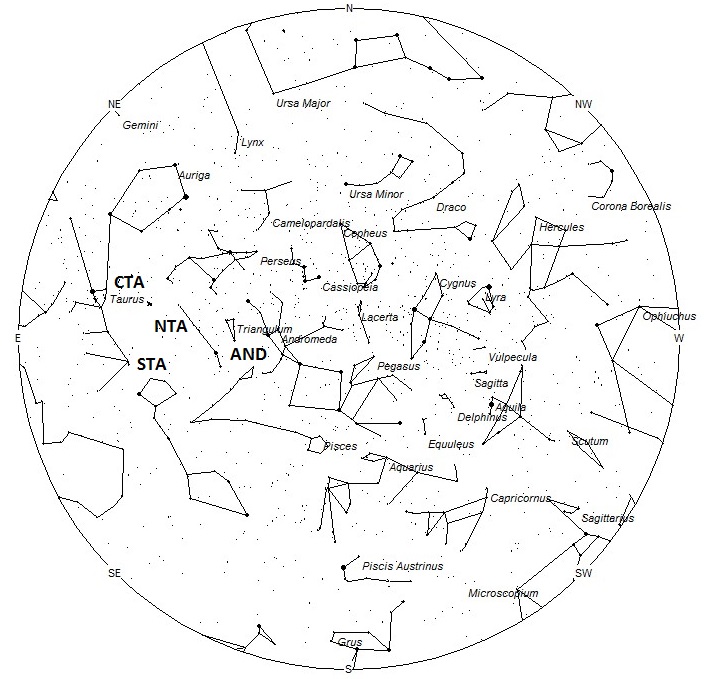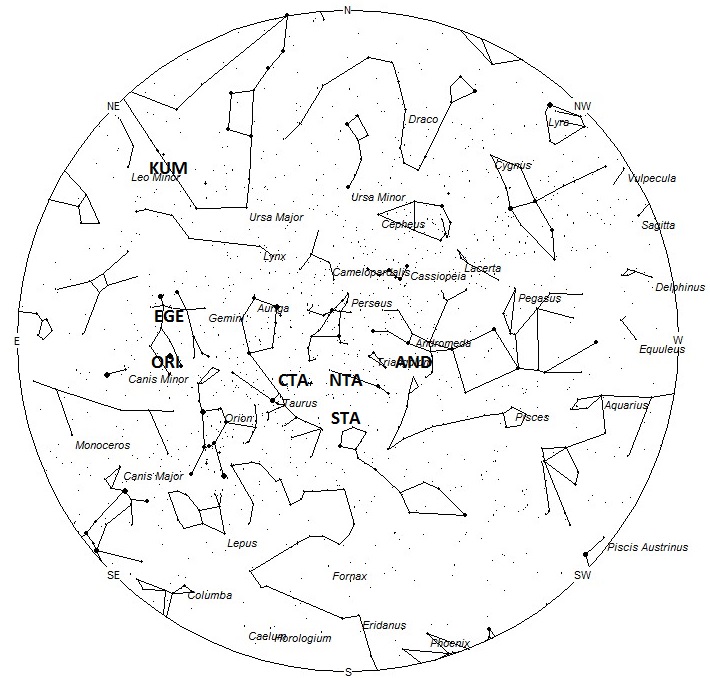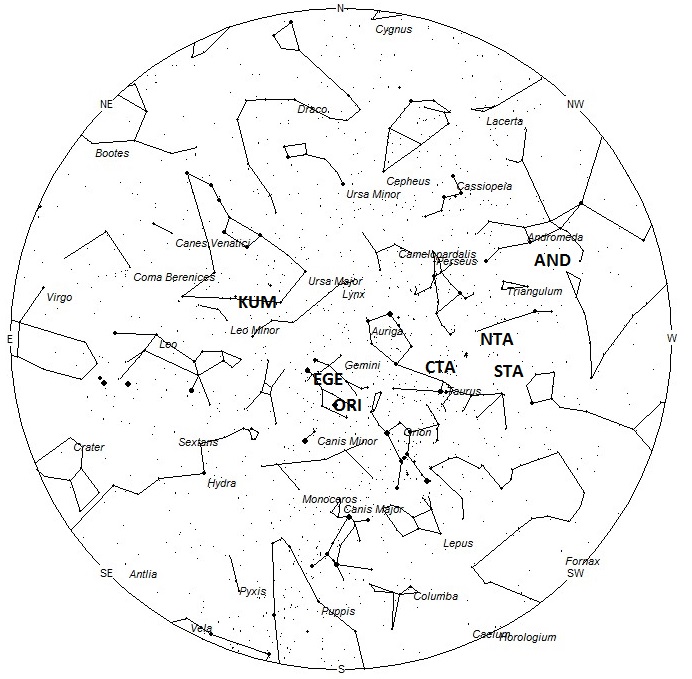
Eta Aquarid meteor – Garner State Park, TX, May 5, 2013. © Sergio Garcia Rill
During this period the moon reaches its last quarter phase on Tuesday November 3rd. On that date the moon will be located 90 degrees west of the sun and will rise near midnight local standard time (LST) as seen from mid-northern latitudes. This weekend the waning gibbous moon will rise during the late evening hours and will obscure all but the brighter meteors the remainder of the night. The estimated total hourly meteor rates for evening observers this week is near 4 as seen from mid-northern latitudes (45N) and 3 as seen from tropical southern locations (25S). For morning observers the estimated total hourly rates should be near 13 as seen from mid-northern latitudes (45N) and 11 as seen from tropical southern locations (25S). The actual rates will also depend on factors such as personal light and motion perception, local weather conditions, alertness and experience in watching meteor activity. Rates during the morning hours are reduced during this period due to moonlight. Note that the hourly rates listed below are estimates as viewed from dark sky sites away from urban light sources. Observers viewing from urban areas will see less activity as only the brightest meteors will be visible from such locations.
The radiant (the area of the sky where meteors appear to shoot from) positions and rates listed below are exact for Saturday night/Sunday morning October 31/November 1. These positions do not change greatly day to day so the listed coordinates may be used during this entire period. Most star atlases (available at science stores and planetariums) will provide maps with grid lines of the celestial coordinates so that you may find out exactly where these positions are located in the sky. A planisphere or computer planetarium program is also useful in showing the sky at any time of night on any date of the year. Activity from each radiant is best seen when it is positioned highest in the sky, either due north or south along the meridian, depending on your latitude. It must be remembered that meteor activity is rarely seen at the radiant position. Rather they shoot outwards from the radiant so it is best to center your field of view so that the radiant lies at the edge and not the center. Viewing there will allow you to easily trace the path of each meteor back to the radiant (if it is a shower member) or in another direction if it is a sporadic. Meteor activity is not seen from radiants that are located below the horizon. The positions below are listed in a west to east manner in order of right ascension (celestial longitude). The positions listed first are located further west therefore are accessible earlier in the night while those listed further down the list rise later in the night.
These sources of meteoric activity are expected to be active this week.
The Andromedids (AND) are active from a radiant located at 01:24 (021) +25, which lies in northern Pisces, 10 degrees northwest of the 2nd magnitude star Hamal (Alpha Arietis). This is a famous shower that produced some brilliant displays during the 19th century. Since then the main orbit of the particles from comet 3D/Biela have moved away from the Earth. Still, remnants may be seen from October 26 through November 20 with maximum activity occurring on November 8. These meteors are best seen near 2300 (10pm) local standard time (LST) when the radiant lies highest above the horizon. Rates would most likely be less than 1 per hour no matter your location. With an entry velocity of 16 km/sec., the average Andromedid meteor would be of slow velocity.
The Northern Taurids (NTA) are active from a large radiant centered at 03:12 (048) +21. This position lies in eastern Aries just 1 degree north of the 4th magnitude star known as Botein (Delta Arietis). The radiant is best placed near midnight LST, when it lies highest above the horizon. Meteors from the Northern Taurids strike the atmosphere at 27km/sec., which would produce meteors of slow velocity. Expected rates would be near 2 per hour, no matter your location.
The Southern Taurids (STA) are currently active from a large radiant centered at 03:12 (048) +15. This position lies in eastern Aries, 5 degrees south of the 4th magnitude star known as Botein (Delta Arietis). These meteors may be seen all night long but the radiant is best placed near midnight LST when it lies on the meridian and is located highest in the sky. Rates at this time should be near 2 per hour regardless of your location. With an entry velocity of 29 km/sec., the average Southern Taurid meteor would be of slow velocity. Note that this position is close to both the radiants of the NTA and the CTA. Care must be taken to differentiate between these meteors. The NTA’s are of similar velocity while the CTA’s would be faster.
The Chi Taurids (CTA) were discovered by Dr. Peter Brown during his 7 year meteoroid stream survey using the Canadian Meteor Orbit Radar. This radiant is active from November 4-8 with maximum activity occurring on the 5th. At maximum the radiant is located at 04:22 (066) +25. This position lies in northern Taurus, 6 degrees east of the naked eye open cluster known as the Pleiades or Seven Sisters. These meteors may be seen all night long but the radiant is best placed near 0100 LST when it lies on the meridian and is located highest in the sky. Rates at maximum would be less than 1 per hour regardless of your location. With an entry velocity of 46 km/sec., the average Chi Taurid meteor would be of medium velocity.
The Orionids (ORI) are active from a radiant at 06:48 (102) +16, which places it in southern Gemini, 2 degrees east of the 2nd magnitude star known as Alhena (Gamma Geminorum). This area of the sky is best placed in the sky near 0400 LST, when it lies highest above the horizon. The expected rates should be near 3 per hour no matter your location. With an entry velocity of 67 km/sec., most activity from this radiant would be of swift speed.
The last of the Epsilon Geminids (EGE) will be seen this week. The current radiant position would be located near 07:32 (113) +26, which places it in eastern Gemini, 4 degrees southwest of the 1st magnitude star known as Pollux (Beta Geminorum). This area of the sky is best placed in the sky near 0500 LST, when it lies highest above the horizon. Current hourly rates should be less than 1 no matter your location. With an entry velocity of 70 km/sec., most activity from this radiant would be of swift speed.
The Kappa Ursae Majorids (KUM) were discovered by cameras of the SonotaCo network in Japan during an outburst of activity on November 5, 2009. This radiant is active from November 2-9 with maximum activity occurring on the 5th. At maximum the radiant is located at 09:44 (146) +45. This position lies in southeastern Ursa Majoris, 7 degrees south of the 3rd magnitude star known as Theta Ursae Majoris. Rates, even at maximum, are not expected to be less than regardless of your location. These meteors are best seen during the last hour before dawn when the radiant lies highest above the horizon in a dark sky. With an entry velocity of 62 km/sec., the average Kappa Ursae Majorid meteor would be of swift velocity.
As seen from the mid-northern hemisphere (45N) one would expect to see approximately 6 sporadic meteors per hour during the last hour before dawn as seen from rural observing sites. Evening rates would be near 3 per hour. As seen from the tropical southern latitudes (25S) morning rates would be near 4 per hour as seen from rural observing sites and 2 per hour during the evening hours. Locations between these two extremes would see activity between the listed figures.
The list below offers the information from above in tabular form. Rates and positions are exact for Saturday night/Sunday morning except where noted in the shower descriptions.
| SHOWER | DATE OF MAXIMUM ACTIVITY | CELESTIAL POSITION | ENTRY VELOCITY | CULMINATION | HOURLY RATE | CLASS |
| RA (RA in Deg.) DEC | Km/Sec | Local Standard Time | North-South | |||
| Andromedids (AND) | Nov 08 | 01:24 (021) +25 | 19 | 22:00 | <1 – <1 | III |
| Northern Taurids (NTA) | Nov 11 | 03:12 (048) +21 | 27 | 00:00 | 2 – 2 | II |
| Southern Taurids (STA) | Oct 10 | 03:12 (048) +15 | 29 | 00:00 | 2 – 2 | II |
| Chi Taurids (CTA) | Nov 05 | 04:22 (066) +25 | 46 | 01:00 | <1 – <1 | IV |
| Orionids (ORI) | Oct 22 | 06:48 (102) +16 | 67 | 04:00 | 3 – 3 | I |
| Epsilon Geminids (EGE) | Oct 22 | 07:32 (113) +26 | 70 | 05:00 | <1 – <1 | II |
| Kappa Ursa Majorids (KUM) | Nov 05 | 09:44 (146) +45 | 62 | 07:00 | <1 – <1 | IV |
 American Meteor Society
American Meteor Society


